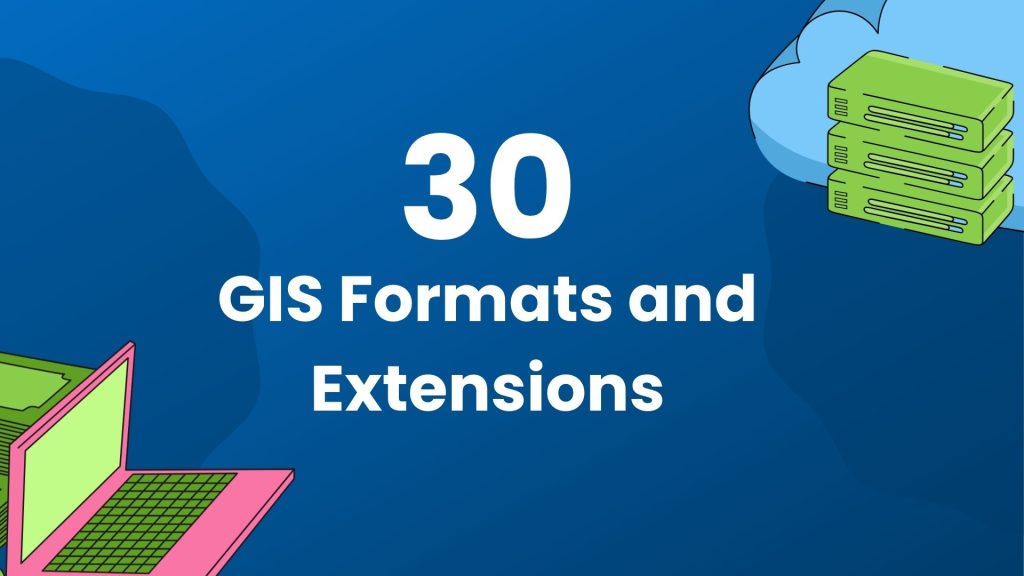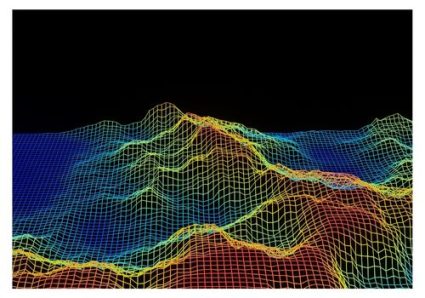Top 30 GIS Formats and Extensions

This article focuses on the storage of GIS data and the various file formats and extensions that exist today. Today, we’ll list the top 30 most popular GIS formats and extensions in the industry:
1. Shapefile (.shp)
This is a popular vector format developed by Esri for storing geospatial data. It consists of multiple files, including .shp, .shx, and .dbf files. But it can also include a .xml file for storing metadata as well as .sbn and .sbx files for indexing and increasing load times.
2. GeoJSON (.json)
GeoJSON is an open standard format for encoding geospatial data based on the JavaScript Object Notation (JSON) format.
3. Keyhole Markup Language (.kml/.kmz)
The keyhole markup language (.kml) is a file format for displaying geographic data on Google Earth. KML was the first version of Google Earth. Afterward, Google replaced it with the updated KMZ format.
4. Geodatabase (.gdb)
Geodatabases are file formats developed by Esri for storing and managing geospatial data in a database format. Before file geodatabases, we used personal geodatabases which were the same extensions (.mdb) as Microsoft Access.

5. GeoTIFF (.tif)
This is a raster format that includes spatial metadata embedded within the file. It is widely for storing and exchanging georeferenced raster data.
6. NetCDF (.nc)
NetCDF is a format for storing and exchanging scientific data, including geospatial and temporal data.
7. GML (.gml)
GML (Geography Markup Language) is an XML-based format used for exchanging geospatial data.
8. PostGIS
This is a geospatial extension for the PostgreSQL database system. It enables the storage, retrieval, and manipulation of geospatial data in a relational database.
9. LAS/LAZ (.las/.laz)
The LAS format is a binary file format developed specifically for LiDAR data. It includes point cloud data, such as elevation and intensity, as well as metadata such as coordinate reference system information. The LAZ format is a compressed version of the LAS format that allows for faster processing and smaller file sizes.
10. MapInfo (.tab)
The MapInfo .tab file is a format developed by Pitney Bowes for storing and exchanging geospatial data. It was widely used in the GIS industry but not as much as shapefiles, geodatabases, and GeoPackages.

11. GPKG (.gpkg)
GeoPackage is a standard format for sharing geospatial data. It includes both vector and raster data and allows for the storage of metadata and styling information.
12. TopoJSON (.topojson)
TopoJSON is a format similar to GeoJSON but optimized for topology and the efficient representation of vector data.
13. MrSID (.sid)
MrSID (Multi-resolution Seamless Image Database) is a lossy compression file format for storing and distributing high-resolution geospatial images.
14. DXF (.dxf)
The DXF format was developed by Autodesk for storing 2D and 3D CAD data, which you can also use to store GIS data.
15. GeoRSS (.xml, .rss)
The GeoRSS format is for encoding and sharing geospatial data as RSS (Really Simple Syndication) feeds.
16. Arc/Info Binary Coverage (.adf)
The Arc/Info Binary Coverage format was developed by Esri for storing raster data in a binary format. However, other formats like GeoTIFF, JPEG2000, and IMG have mostly replaced this GIS format.
17. GeoTIFF (.tif)
A GeoTIFF is a format used for storing georeferenced raster data, such as satellite imagery and aerial photography. They can contain additional metadata such as coordinate reference system information and are widely used in GIS software.

18. ERDAS Imagine (.img)
A proprietary format developed by Hexagon Geospatial for storing raster data. ERDAS Imagine is commonly used in remote sensing applications and is supported by many GIS software packages.
19. JPEG (.jpg)
JPEG is a compressed image format commonly used for storing photographs and other images. They can also be georeferenced and used as raster data in GIS applications such as for basemaps.
20. JPEG2000 (.jp2)
JPEG2000 spatial format is a wavelet-based image compression standard that provides high image quality, efficient compression, and the ability to selectively decode specific parts of an image.
21. Esri Grid (.asc)
The Esri Grid format was developed by Esri for storing raster data in a grid format. GIS professionals use Esri Grid files for terrain analysis, land cover classification, and other raster-based GIS applications.
22. DWG (.dwg)
This is a proprietary format used by AutoCAD for storing CAD (Computer-Aided Design) data, which can include geospatial data.

23. ASCII (.xyz)
An ASCII file format that stores LiDAR point cloud data in a simple text format. It includes x, y, and z coordinates for each point, as well as other attributes such as intensity.
24. GPX (.gpx)
GPX (GPS Exchange Format) is a file format for storing and exchanging GPS (Global Positioning System) data, such as waypoints, routes, and tracks, between GPS devices and software applications.
25. OSM (.osm)
OSM (OpenStreetMap) format is an open, XML-based file format for storing geospatial data, including streets, buildings, and points of interest, that can be edited and used by anyone.
26. DLG (.dlg)
DLG (Digital Line Graph) format is a vector file format used by the United States Geological Survey (USGS) for storing cartographic data, such as contour lines, hydrography, and transportation networks, in a standardized manner.
27. ECW (.ecw)
ECW (Enhanced Compression Wavelet) format is a proprietary, high-performance file format used for storing and distributing geospatial imagery, which employs wavelet compression techniques to achieve high compression ratios without significant loss of image quality.

28. MBTILES (.mbtiles)
MBTiles (MapBox Tiles) is a file format for storing and serving tiled map data, which consists of a collection of small, square images, organized into a grid and optimized for fast rendering in web and mobile applications.
29. SDTS (.sdts)
Spatial Data Transfer Standard is a format developed by the USGS for transferring spatial data between different computer systems.
30. SQLite (.sl3)
Spatialite is an open-source, lightweight, spatial extension for SQLite, a popular embedded relational database, which adds support for storing, querying, and manipulating geospatial data in a compact and efficient manner.
GIS Formats and Extensions
In this article, we have covered 30 of the most popular GIS formats and extensions, ranging from raster and vector data formats to CAD, GPS, and remote sensing data formats. Each of these formats and extensions has its unique features, advantages, and limitations, which make them suitable for Geographic Information Systems (GIS).
